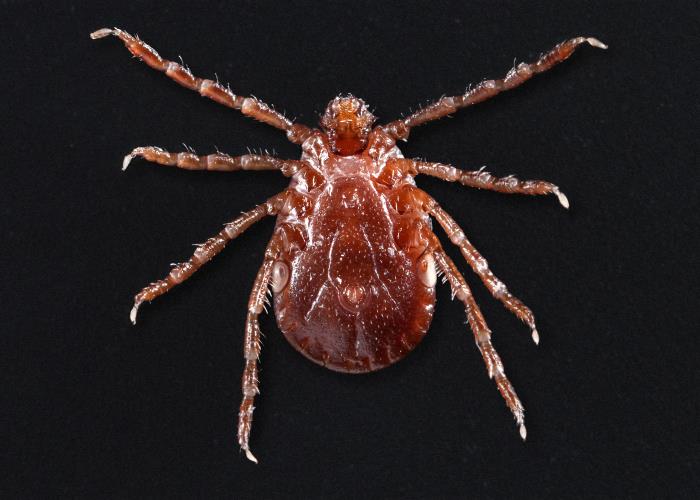Ticks have been a growing menace across the United States, and now a new tick species called the longhorned tick has been found in New York City for the first time, concerning some health experts.
The New York City Health Department on Wednesday announced that the longhorned tick, although never before seen within the five boroughs, has been identified in the southern section of Staten Island.
The longhorned tick, scientific name Haemaphysalis longicornis, is spreading along the East Coast, as well, marking the first time a new tick species has popped up in 50 years, the New York Times recently reported.
But what is it about the longhorned tick that has public health officials concerned? Here’s what you need to know.
What is the longhorned tick?
The longhorned tick is an Asian tick species that can self-clone, meaning it can reproduce asexually through a process called parthenogenesis. This means that female longhorned ticks can lay hundreds of eggs without mating, thus reproducing into large numbers quickly.
The longhorned tick is native to Japan, China and Korea and often found in Australia and New Zealand, as well. But recently, it has been spreading throughout the states.
The tick species first appeared in Hunterdon County, New Jersey in 2017, and this summer, the pest has been identified in more areas of New Jersey and Westchester County in New York, as well as Pennsylvania, Virginia, West Virginia, North Carolina and Arkansas.
The New York State Health Department in July announced that the longhorned tick was found in multiple locations within Westchester County, warning all New Yorkers, and especially farmers, to take more general precautions against ticks, like wearing long pants or long sleeve shirts when in wooded areas, using repellents and checking for ticks often whenever outdoors.
“Taking steps to protect yourself, your children and pets against ticks is the best way to prevent tick bites and tickborne diseases,” State Health Commissioner Dr. Howard Zucker said in a statement. “We will continue to conduct surveillance and research on this new type of tick, but it is encouraging that the same steps that protect against deer ticks are also effective against the longhorned tick.”
Now that the longhorned tick has been found within New York City, city officials promise to aggresively monitor its presence.
“This new discovery underscores the importance of our recent efforts to control the tick population and educate Staten Islanders about protecting themselves from Lyme disease and other tick-borne illnesses,” said Staten Island Borough President James Oddo in a statement. “We will continue to work with the administration on tick control methods, including our bait box initiative, as well as focus on educating local residents on how to prevent tick bites.”
Do longhorned ticks carry disease?
When the New York State Health Department first announced the arrival of the longhorned tick in New York this summer, experts cautioned that the longhorned tick has transmitted disease to humans in other parts of the world, but that more research is needed to determine whether this can happen in the United States.
The longhorned ticks found in New Jersey have not been found to carry pathogens or to bite people so far, according to researchers at the Rutgers University Center for Vector Biology in a June 2018 report.

However, the researchers note, in the species’ native areas in Asia, the longhorned tick has been known to infect humans with several diseases, some of which are fatal.
The biggest threat to humans from longhorned ticks in Asia is, per the Times, a phlebovirus that causes severe fever with thrombocytopenia syndrome, or SFTS. Thrombocytopenia is a condition in which someone has a low blood platelet count; platelets help your blood clot, so a drop in them can cause internal bleeding. SFTS from longhorned ticks can lead to multiorgan failure and across Asia has been found to have a fatality rate between 12 and 30 percent.
Most health experts in the U.S. are warning that longhorned ticks may pose a particular threat to livestock and pets. The species is also called the cattle tick or bush tick, because longhorned ticks are often found on animals.
When the longhorned tick was first found in western New Jersey, a sheep on a Hunterdon County farm was found covered in them. Earlier this month, Aug. 3, a longhorned tick was found on a white-tailed deer in Harrisburg, Pennsylvania.
“While we continue to learn more about the longhorned tick, it is evident that this species may possibly cause illness not only in humans, but also in livestock and our pets,” New York State Agriculture Commissioner Richard A. Ball said in a statement. “We encourage farmers to be vigilant and keep a watchful eye out for this tick to protect their animals and stay ahead of any potential problems for the livestock industry in New York State.”
The city health department has already amped up its tick surveillance, officials said, and will continue to do so in light of the discovery of longhorned ticks here. The agency will conduct tick surveillance in 31 sites, including 28 in Staten Island, two in the Bronx and one in Brooklyn. Fifteen pilot sites were also surveyed between May and July, the height of tick season, in Manhattan, the Bronx, Brooklyn and Queens.
To keep New Yorkers safe against tick bites in general, New York City Health Commissioner Dr. Mary T. Bassett is advising New Yorkers to wear light colored clothing, use repellent, clear tall grass and brush from around your home, and to check yourself, your children and your pets for ticks frequently.
Tick diseases spreading overall: Lyme Disease up across U.S.
The longhorned tick has not been found to carry Lyme disease, but that is also on the rise across the U.S., thanks to blacklegged and deer ticks. The tick-borne disease has spread to all 50 states, according to a recent report from Quest Diagnostics.
Quest Diagnostics, a clinical laboratory headquartered in New Jersey and with locations throughout New York City, looked at more than six million laboratory test results from the past seven years to understand the rise of Lyme disease.
The disease has always been most prevalent in the Northeast, and continues to remain widespread in Pennsylvania, Connecticut, Maine, Massachusetts, New Hampshire, Rhode Island and Vermont. Those states accounted for more than 60 percent of the total number of positive Lyme disease test results found in the U.S. in 2017, per the report.
Recently, though, the number of Lyme disease cases has increased dramatically across the country. With 483 Lyme disease infected patients in 2017, California saw a 194.5 percent increase over its 2015 levels; and with 501 infected patients in Florida in 2017, that state saw a 77 percent increase in Lyme disease.
“Lyme disease is a bigger risk to more people in the United States than ever before,” said Harvey W. Kaufman, M.D., senior medical director for Quest Diagnostics, in a statement. “Our data show that positive results for Lyme are both increasing in number and occurring in geographic areas not historically associated with the disease. We hypothesize that these significant rates of increase may reinforce other research suggesting changing climate conditions that allow ticks to live longer and in more regions may factor into disease risk.”



















